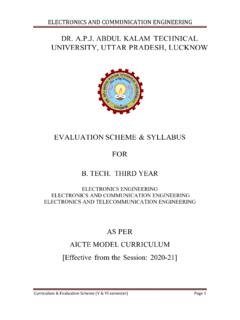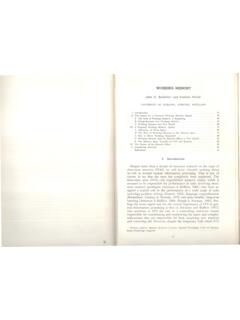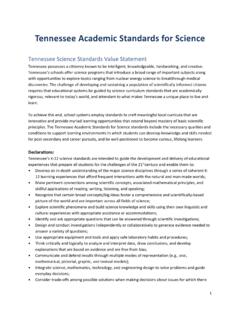Transcription of Working Memory and Second Language Processing
1 RUNNING HEAD: Working Memory and LanguageWorking Memory and ( Second ) Language processingArnaud Szmalec, Marc Brysbaert, Wouter Duyck Ghent University, BelgiumContact:Arnaud SzmalecDepartment of Experimental PsychologyGhent UniversityHenri Dunantlaan 2B-9000 Ghent Chapter submitted for:J. Altarriba and L. Isurin (Eds.). Memory , Language , and bilingualism: Theoretical and applied approaches. Cambridge: Cambridge University Press. Working Memory and Language 1 AbstractThis chapter discusses the interactions between two of the most important human cognitive functions: Memory and Language . First, the concept of Working Memory is introduced, along with a brief summary of the evolutions that Working Memory theory has undergone in the last decades. The Second part of the chapter focuses on the role of (verbal) Working Memory in Language acquisition and Processing . It is argued that Working Memory , and especially the ability to temporarily represent serial-order information, is crucially involved in both native and foreign word learning, and perhaps also in sentence and text comprehension.
2 The third and final part of the chapter explores the other direction of the interaction, by questioning whether Language Processing can influence Working Memory functioning. This question is addressed with recent behavioral and neurological evidence for a general executive control advantage in bilinguals, which makes a strong case for the trainability of some aspects of Working Memory . Keywords: Working Memory , Language acquisition, Language Processing , executive control, bilingualism Working Memory and Language 2 Working Memory and ( Second ) Language Processing From intelligence testing to Working Memory In 1887, Jacobs published a series of studies in which he reported that older children could repeat longer strings of digits read out to them than younger children. Jacobs also reported that intelligent children (as assessed by the teacher) could repeat more digits than less intelligent children.
3 This idea was picked up by Binet and Simon in the early 20th century when they developed the first valid intelligence test. They found that 3-year old children could repeat only sequences of two digits, whereas children of 4 years could repeat sequences of three digits, and most healthy children of 7 years could repeat sequences of five digits. Therefore, Binet and Simon included digit repetition in their intelligence test (Binet & Simon, 1905). Ever since, the digit span task (as it became called) has been part of intelligence tests, because it correlates reasonably well with the scores of other subtests of intelligence (such as arithmetic, general information, and the discovery of similarities). The task received further impetus when Miller (1956) argued it was a good measure of a person s short-term Memory capacity. In the early 1970s several authors felt uneasy with the digit-span as a measure of Memory capacity. It seemed to consider short-term Memory too much as a passive storage buffer, rather than an active part of human information Processing .
4 As a result, the concept of Working Memory , representing both storage and executively controlled manipulation of information, was put forward. An important publication in this respect was the Working Memory model of Baddeley and Hitch (1974). This model consisted of three parts: (i) a modality-free central executive related to attention, (ii) a phonological loop holding information in a speech-based form, and (iii) a visuo-spatial sketchpad for the coding of visual and spatial information. A further milestone was the publication by Daneman and Working Memory and Language 3 Carpenter (1980) of an article in which they presented the reading span task as a measure of Working Memory capacity. This task (also known as the complex span task) was developed to simultaneously tax the storage and Processing functions of Working Memory . Participants had to read sentences (the Processing component) while maintaining and retrieving the final words of the sentences (the storage component).
5 An example of a test item with two sentences was:- When at last his eyes opened, there was no gleam of triumph, no shade of The taxi turned up Michigan Avenue where they had a clear view of the reading aloud these two sentences the participant had to retrieve the two last words (anger, lake). The number of sentences was increased until the participants made errors. Daneman and Carpenter (1980) observed that reading span typically varied from 2 to 5 words. They further discovered that this span correlated much better with reading comprehension and performance on the Scholastic Aptitude Test (SAT; a standardized test for college admission in the US) than the traditional, passive word span (measured by presenting lists of words of varying length to participants and asking them to repeat the lists). Subsequent reviews confirmed the high correlations between Working Memory capacity and Language comprehension (Daneman & Merikle, 1996), and between Working Memory capacity and fluid intelligence (Ackerman, Beier, & Boyle, 2005; Engle, Tuholski, Laughlin, & Conway, 1999).
6 A wide variety of immediate serial recall tasks and complex span measures are in use today to increase our understanding of the structure and the functioning of Working Memory . At the same time, the conceptualization of Working Memory has gone through some substantial changes. Whereas Daneman and Carpenter (1980) considered Working Memory as a unitary system with a single capacity, later research provided evidence for several subcomponents with their own capacities. For instance, Jarrold and Towse (2006), in line with Working Memory and Language 4 Baddeley and Hitch s (1974) model, argued that Working Memory capacity depended on (i) Processing efficiency, (ii) storage capacities for the maintenance of verbal/numerical information and spatial information, and (iii) controlled attention needed for the coordination and integration of storage and Processing , and for the inhibition of irrelevant information. Still other Working Memory theorists started to question the idea of Working Memory as a separate module.
7 Partially inspired by the work of Cowan (1988), which was further elaborated by Oberauer (2009), they have questioned the multiple-component view of Memory and argued that short-term Memory , long-term Memory , and Working Memory are not separate structures but differ from each other in terms of activation levels of representations in Memory and the amount of attentional control dedicated to those representations. Working Memory then is seen as an activated subset of long-term Memory , with information in a directly accessible state and shielded against interference from other Memory contents through attentional control ( , Szmalec, Verbruggen, Vandierendonck, & Kemps, 2011). In this view, the same Memory processes (recall, recognition, recollection, stimulus familiarity, ) operate in the entire Memory system ( , Goethe, & Oberauer, 2008; Oztekin & McElree, 2007) and the structural differentiation between Memory subsystems is largely abandoned.
8 This assumption is based on a wide variety of behavioral and neurophysiological evidence showing that long-term and Working Memory are in much closer interaction than initially thought (which also led to the introduction of the Episodic Buffer in the traditional Working Memory model; Baddeley, 2000). Probably one of the best examples of the close collaboration between Working Memory and long-term Memory is Language acquisition. How Working Memory supports Language acquisitionWhy a Working Memory for Verbal Information? Working Memory and Language 5A longstanding tradition in Memory research draws a distinction between verbal and visuospatial information, on which different Memory processes operate. This division was explicitly present in the Working Memory model of Baddeley and Hitch (1974) and it remains present in many recent models. The need for a visuospatial ( Working ) Memory is easy to assert on the basis of evolutionary grounds.
9 A visuospatial Working Memory provides a survival advantage because it allows for the retention of visual and spatial information when the information is no longer accessible from the sensory registers (see Vandierendonck and Szmalec, 2011, for a collection of recent papers on spatial Working Memory theory). Such a Memory system allows an organism, for example, to keep track of its nest and to remember where prey is hiding or where predators are likely to be waiting. Scientists have sought for similar evolutionary factors behind the verbal part of ( Working ) Memory : Why did humans evolve the capacity to (briefly) retain speech-based information? What is the evolutionary purpose of Working Memory for speech-based materials? It seems unlikely that verbal Working Memory developed to perform well in cognitive psychology experiments, where participants are asked to recall lists of digits, syllables, telephone numbers, words or other artificial stimuli cognitive psychologists are interested in.
10 What could be the etiology of verbal Working Memory ? An important breakthrough was published in a seminal paper by Baddeley, Gathercole, and Papagno (1998). On the basis of a literature review, they proposed that verbal Working Memory primarily represents "the processes and mechanisms by which the sound patterns of the words of the native Language are learned by the child" (p. 159). Similar perspectives on verbal Working Memory had been introduced before, as in the work of Martin and Saffran (1992) who suggested that short-term Memory for verbal information was merely an emergent property of the temporary activation of linguistic information. However, the conceptualization Working Memory and Language 6of Baddeley et al. (1998) was more dynamic and open to individual differences, as typically investigated in Working Memory research. As a result, Baddeley et al. (1998) have been highly influential and stimulated a lot of new research, which is summarized Working Memory and the Learning of New WordsBaddeley et al.




